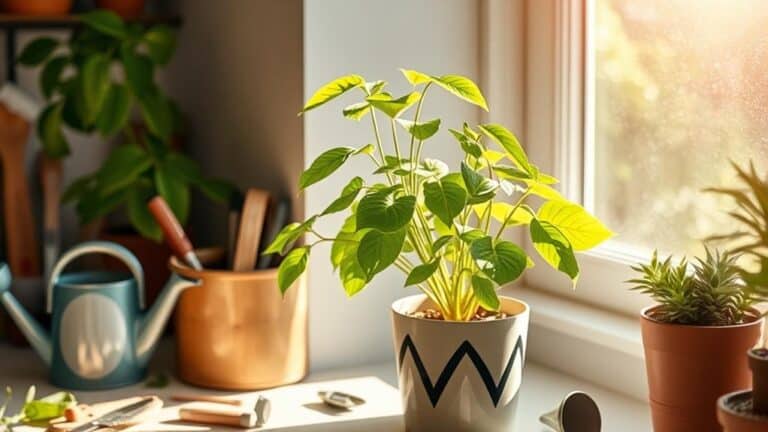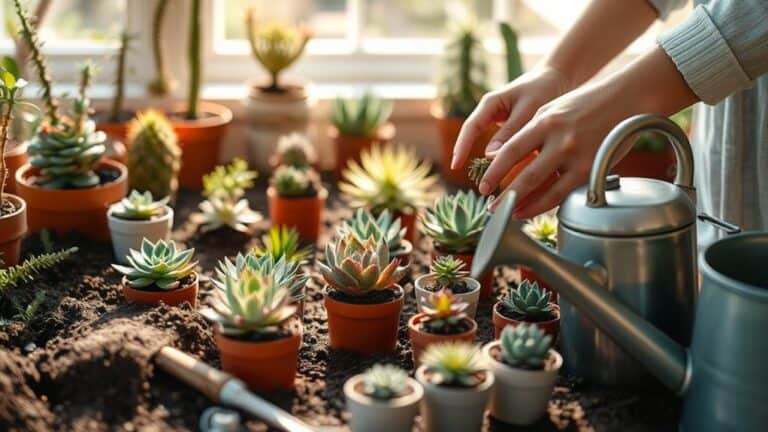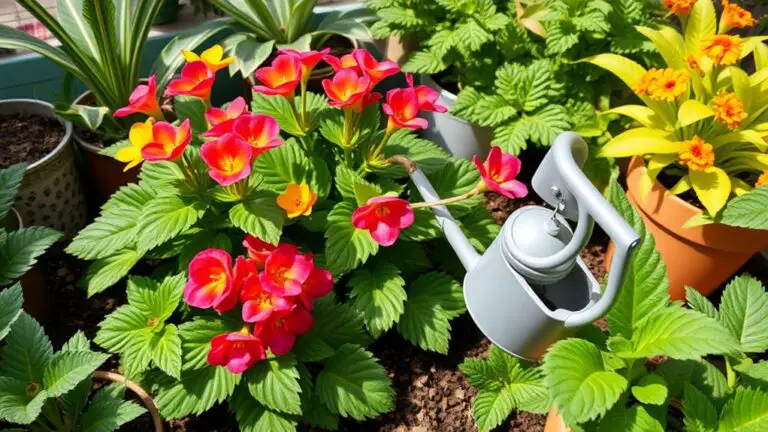5 Effective Tips to Manage Mushrooms in Your Houseplants
If you've noticed mushrooms popping up in your houseplants, it might be time to rethink your plant care routine. You don't need to panic; managing these fungi is simpler than you might think. By understanding the key factors that encourage their growth, you can make a few adjustments to keep your plants healthy and mushroom-free. So, what's the first step in tackling this issue? Let's explore how identifying the root causes can set you on the path to a cleaner, healthier indoor garden.
Identify Causes
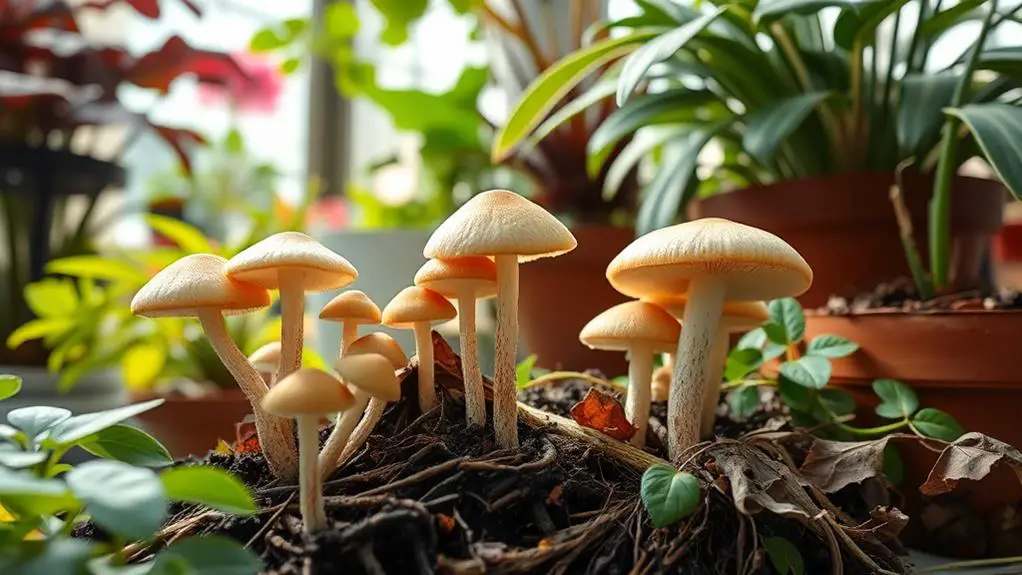
Identifying the causes of mushrooms in houseplants is crucial to effectively managing them. First, consider your soil. Spores often enter through contaminated potting mixes or by attaching themselves to your clothing. Once in the soil, they can thrive under certain conditions.
High moisture levels, often from overwatering, create the perfect environment for these fungi. So, make certain you're not watering too much.
Drainage is another key factor. Poor drainage can lead to waterlogged soil, which mushrooms love. Verify your pots have proper drainage holes to let excess water escape.
Organic material in the potting mix, like decomposing plant matter, also encourages mushroom growth. This organic material provides food for fungi, making it easier for them to multiply.
Humid conditions inside your home, especially during summer, can further promote mushroom development.
Maintaining good air circulation is another important step. Poor air circulation can trap humidity, creating an ideal environment for spores to spread and grow.
Remove Existing Mushrooms
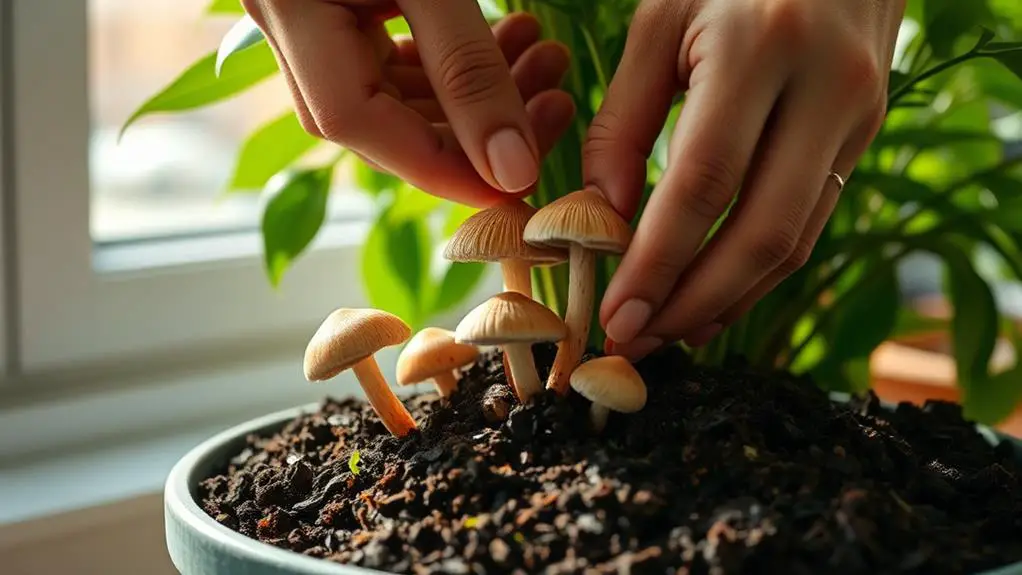
Dealing with existing mushrooms in your houseplants requires a methodical approach to prevent their return and spread. Start by quarantining affected plants to keep spores from reaching other houseplants.
When you're ready to remove existing mushrooms, wear gloves to protect your hands. Carefully hand-pick the mushrooms and scrape off the top 2 inches of soil. This helps remove the spores and roots that could cause mushrooms to keep returning.
Next, dispose of the removed soil in an outdoor bin. Doing this stops the contaminated soilless mix from reintroducing spores into your home. Replace the old soil with a fresh layer of soil, choosing a sterile potting mix to give your plants a healthier environment. This fresh layer of soil will also help in preventing new mushrooms from sprouting.
If mushrooms keep returning despite your efforts, consider using a natural fungicide. Drench the soil thoroughly, and you might need to apply the fungicide multiple times to fully eradicate the problem.
Taking these steps guarantees you're removing mushrooms effectively and giving your houseplants the best chance to thrive without unwanted fungi. Remember, patience and persistence are key in managing houseplant mushrooms.
Adjust Watering Practices

Proper watering practices play an important role in preventing mushroom growth in houseplants. To avoid over-saturation, water your plants only when the top inch of soil feels dry to the touch. This helps maintain the right moisture levels and reduces the chance of mushroom growth.
You should also set a consistent watering schedule that matches each plant's specific needs, considering factors like humidity and temperature. This can prevent excess moisture that mushrooms thrive on.
Using pots with drainage holes is another effective way to manage water runoff. These holes guarantee that water doesn't pool at the bottom, which can increase fungal growth.
Additionally, selecting well-draining soil is vital. This type of soil helps control moisture levels, making it harder for mushrooms to grow.
Don't forget to monitor the environmental humidity around your houseplants. High humidity can make it easier for mushrooms to develop.
If your home is particularly damp, consider using a dehumidifier. This device can help maintain a balanced humidity level, creating a less favorable environment for mushrooms.
Improve Soil Conditions

To effectively manage mushrooms in houseplants, improving soil conditions is key. You'll want to start by using well-draining potting soil to reduce moisture retention. This is crucial for preventing mushrooms from growing. Incorporate materials like perlite or vermiculite into your potting mix. These additives enhance aeration and drainage, creating an environment that's unfavorable for fungi.
Regularly monitor soil moisture levels. Only water your plants when the top inch of soil feels dry to the touch. This practice minimizes damp conditions that encourage mushrooms. Consider using sterile potting soil to eliminate any existing fungal spores. Sterile soil helps prevent future mushroom growth, giving your houseplants a fresher start.
Amending your soil with a layer of fine gravel or pebbles on top can also help improve drainage. This layer allows better airflow and deters mushroom formation. It's a simple step that makes a big difference in your plant's health.
If you notice mushrooms starting to grow, you can easily remove them by hand.
Improving soil conditions is a straightforward way to keep mushrooms at bay and guarantee your houseplants thrive. Keep these tips in mind for healthier, happier plants.
Maintain Low Humidity
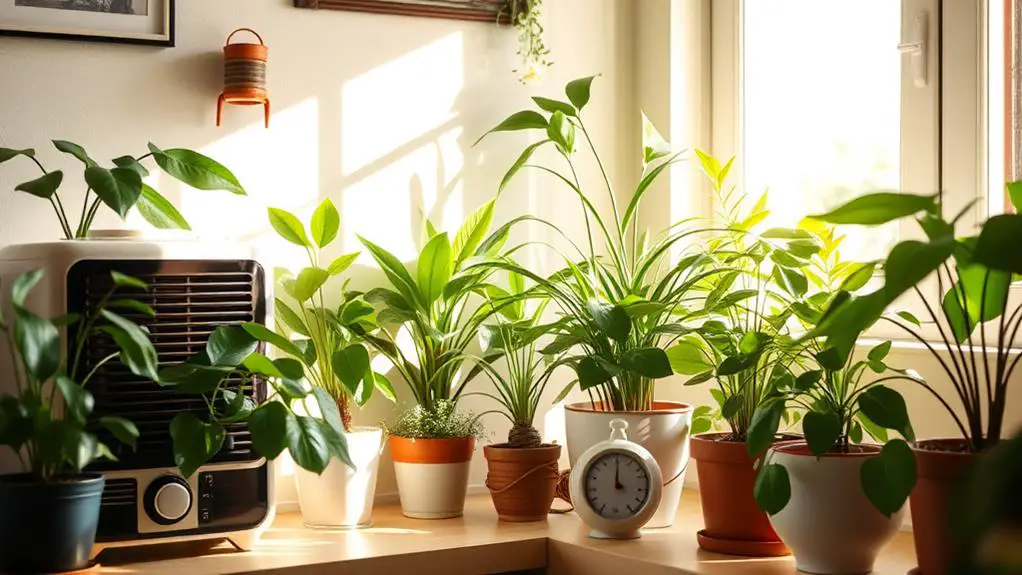
Keeping indoor humidity levels low is essential for preventing mushrooms from sprouting in your houseplants. High humidity creates ideal conditions for mushrooms to thrive, so it's vital to maintain low humidity levels between 30-50%.
Using a dehumidifier can effectively reduce moisture in the air, helping to prevent mushrooms in your houseplant soil.
Monitoring humidity with a hygrometer is also a smart move. This device helps you keep an eye on the humidity levels and make adjustments before mushrooms become an issue.
Placing your plants in well-ventilated areas can improve air circulation, which further reduces humidity around your houseplants.
Proper drainage is another key factor. Make sure your pots have good drainage holes to let excess water escape.
Overwatering your plants can increase soil moisture, creating a perfect environment for mushrooms to grow. Be mindful of your watering habits and always check if the soil needs water before adding more.
Frequently Asked Questions
How to Get Rid of Mushrooms in Indoor Plants?
To get rid of mushrooms in your indoor plants, hand-pick them, scrape off the top soil layer, repot with sterile mix, and apply fungicide if needed. Make certain you let the soil dry out between waterings and quarantine affected plants.
Should I Leave Mushrooms in My Potted Plants?
You can leave mushrooms in your potted plants; they decompose organic matter and enrich the soil. However, if you have pets or children, removing them is safer due to their mild toxicity. Adjust watering to prevent overgrowth.
What Kills Indoor Mushrooms?
To kill indoor mushrooms, manually remove them, scrape away contaminated soil, and apply fungicide. Let soil dry out between waterings, guarantee proper drainage, sprinkle cinnamon, and monitor humidity levels to create an environment that deters mushroom growth.
Do Coffee Grounds Help Mushrooms?
Yes, coffee grounds can help mushrooms. They add organic matter and nitrogen to the soil, which fungi love. Just mix them well and use sparingly to prevent a damp environment that promotes excessive mushroom growth.
Conclusion
You've got this! By identifying the causes, removing existing mushrooms, adjusting your watering practices, improving soil conditions, and maintaining low humidity, you can keep your houseplants healthy and mushroom-free. Remember, it's all about keeping the soil well-drained and ensuring good air circulation. Don't be afraid to make changes and experiment with what works best for your plants. With these tips, you'll be a confident and successful indoor gardener in no time!


